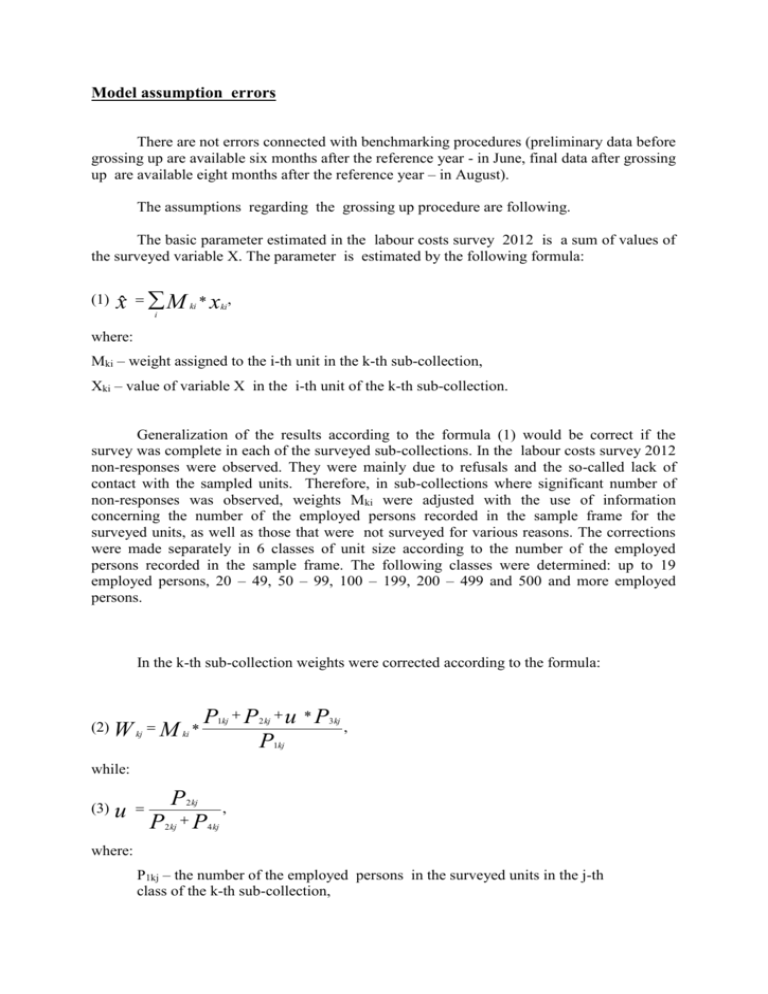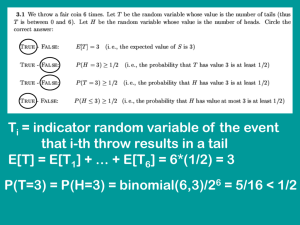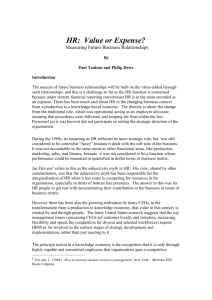Model assumption errors
advertisement

Model assumption errors There are not errors connected with benchmarking procedures (preliminary data before grossing up are available six months after the reference year - in June, final data after grossing up are available eight months after the reference year – in August). The assumptions regarding the grossing up procedure are following. The basic parameter estimated in the labour costs survey 2012 is a sum of values of the surveyed variable X. The parameter is estimated by the following formula: (1) xˆ M ki i xki, where: Mki – weight assigned to the i-th unit in the k-th sub-collection, Xki – value of variable X in the i-th unit of the k-th sub-collection. Generalization of the results according to the formula (1) would be correct if the survey was complete in each of the surveyed sub-collections. In the labour costs survey 2012 non-responses were observed. They were mainly due to refusals and the so-called lack of contact with the sampled units. Therefore, in sub-collections where significant number of non-responses was observed, weights Mki were adjusted with the use of information concerning the number of the employed persons recorded in the sample frame for the surveyed units, as well as those that were not surveyed for various reasons. The corrections were made separately in 6 classes of unit size according to the number of the employed persons recorded in the sample frame. The following classes were determined: up to 19 employed persons, 20 – 49, 50 – 99, 100 – 199, 200 – 499 and 500 and more employed persons. In the k-th sub-collection weights were corrected according to the formula: (2) W kj M ki P 1kj P2 kj u P3kj P , 1kj while: (3) u P P 2 kj 2 kj P4 kj , where: P1kj – the number of the employed persons in the surveyed units in the j-th class of the k-th sub-collection, P2kj – the number of the employed persons in the units that were not surveyed due to refusals in the j-th class of the k-th sub-collection, P3kj – the number of the employed persons in the units that were not surveyed due to lack of contact in the j-th class of the k-th sub-collection, P4kj – the number of the employed persons in the units that were not surveyed due to lack of activity, liquidation or bankruptcy of the unit in the j-th class of the k-th sub-collection. The formulas (2) – (3) indicate that weights correction covered non-responses caused by refusals and in proportion to the number of refusals those that were due to lack of contact with a sampled unit. Values of the variable X for the k-th sub-collection estimated with the appliance of weights Mk or Wkj, were then aggregated, according to the needs, into NACE divisions and sections, ownership sectors and for the whole national economy. Moreover, quotients of variables X/Y e.g. labour costs per one employee were also estimated on different aggregation levels. The next assumptions regarding labour costs survey are as follows: Labour costs survey cover calendar year figures. Where is necessary we ask the reporting units to supply calendar year estimates. Small enterprises, in this case enterprises with less than 10 employees, have not been accounted for. No combinations between survey data and data from administrative source have been done. That is, all data come from the survey results.







